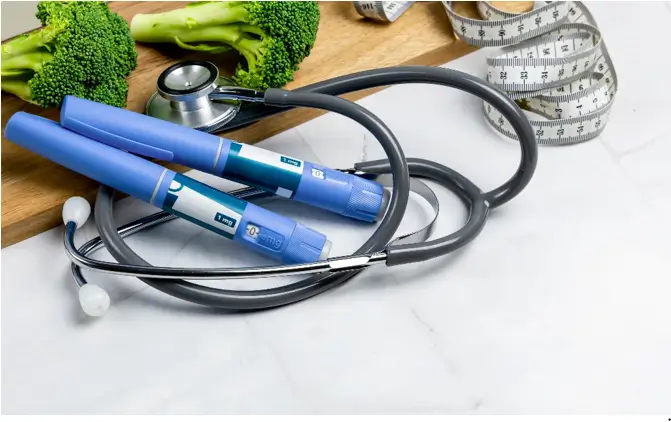Remission of Obesity and creating an off ramp
The goal of treatment for obesity in the functional medicine model is to achieve remission and improve the “mitigating factors.” The factors that add fuel to the fire and contribute to the chronic condition in the first place. Never has this topic been more salient with the availability of obesity pharmaceuticals. Medications such as semaglutide and tirzepatide are helpful in “putting out the fire.” There are however a host of factors that led to the fire in the first place. According to obesity treatment guidelines, most patients benefit from staying on obesity medications indefinitely. Philosophically, this does not settle well in the functional medicine model, nor with patients desiring a personalized approach to their care. It is true that the studies on cessation of GLP-1/ GIP agonist medication did lead to weight regain (approximately two-thirds of total weight loss). This was with abrupt cessation and minimal reported attention to lifestyle changes.
The question then becomes can we combine the use of GLP-1/GIP medication for weight loss and functional medicine to successfully treat and put into remission obesity and sustain remission. We always have the goal of “de-prescribing” for other chronic conditions – such as Hypertension and Type 2 Diabetes, so why not with the treatment of obesity as well.
Strategies for the “Off Ramp” when it comes to pharmaceutical treatment of obesity.
Building Block 1- Intention with Treatment
We start with the intention at the beginning of treatment. Using the medications as a tool to help with sustaining a whole foods diet as a goal for habit building at the beginning. Here are two statements that illustrate how we want to frame obesity treatment:
Taking Semaglutide is going to lead to weight reduction.
Taking Semaglutide is going to help me make lifestyle changes and build healthy habits that will help me lose and maintain a healthy weight.
Building Block 2- Food Quality Matters
Eating for nutrient density takes practice. The benefit often described by patients using medications is that they feel food is a non-priority or issue as it was in the past. The less you eat the more important the quality of the food you are eating. When food is less of a priority when it comes to cravings and hedonic or pleasure drive to eat, we need to shift our thinking to prioritize nutrient density- not just macronutrients (protein, fat, and carbohydrates) but micronutrients as well (vitamins and minerals). Eating for nutrient density is whole food based and often more satiating and less likely to contribute to overnutrition. We know that highly processed foods increase overconsumption of calories from some nicely done studies. When we shift to whole foods for nutrients, we are eating more fiber, and the foods take up more volume in the stomach and we will naturally increase GLP-1 production with eating. This will come in handy in “building” the off ramp for de-prescribing later.
Building Block 3- Exercise Matters
Another building block of the off ramp is exercise. When we lose weight – our metabolic rate declines. This is one of the tragedies of having gained weight and then lost it- you will burn less calories than where you started. This is why a lot of the studies on weight loss maintenance support exercise as being a key factor in success. Exercise increases how many calories we burn. Adding strength training will also help as muscle mass increases basal metabolic rate as well. Patients who engage in regular exercise with their weight loss and maintenance plans tend to keep more of their lean body mass. We want to promote loss of fat mass over muscle so that if we do reduce or stop obesity treatments, metabolic rate will not be as affected.
Building Block 4- Stress Matters
We eat for a lot of reasons. Stress affects our metabolism and our emotional drive to eat. During treatment it is important to pay attention to mental health for several reasons. There are some studies suggesting higher risk of depression and even suicidality in a small percentage of patients on GLP-1 medications. There are several hypotheses as to why this may be. There is no doubt that food is a coping mechanism for many people. Working on our thought patterns and stress management tools during and after treatment is key.
Building Block 5- Stepwise De-prescribing
We have learned abrupt cessation of medication is a risk factor for weight regain. A gradual reduction in medication dose and frequency of administration just makes sense with the body’s homeostatic mechanisms. This could look like lower doses every 10-14 days over time. There is no guideline, meaning there are no randomized controlled trials – with personalized medicine we have to create our own plan.
Building Block 6 Use of step-down treatments
There are other less famous pharmaceutical medications used for weight reduction. Some have been studied as part of step-down treatment options including metformin, topiramate and semaglutide. To offset the rebound of hunger and minimize risk of weight gain, these are some tools that can be used if needed when developing a personalized off ramp.
Building Block 7- Address other underlying factors for obesity
In the functional medicine model, we look at the full picture. Alterations in the microbiome along with exposure to toxicants are potential factors in obesity. Blood glucose dys-regulation (which GLP-1 medications assist with) along with mitochondrial health / energy metabolism and hormone balance are all factors that may be relevant. Creating an individualized comprehensive treatment plan where GLP-1 pharmaceuticals are just one facet is key for maintenance of remission and long-lasting success.
References:
Wilding JPH, Batterham RL, Davies M, Van Gaal LF, Kandler K, Konakli K, Lingvay I, McGowan BM, Oral TK, Rosenstock J, Wadden TA, Wharton S, Yokote K, Kushner RF; STEP 1 Study Group. Weight regains and cardiometabolic effects after withdrawal of semaglutide: The STEP 1 trial extension. Diabetes Obes Metab. 2022 Aug;24(8):1553-1564. doi: 10.1111/dom.14725. Epub 2022 May 19. PMID: 35441470; PMCID: PMC9542252.
Paddu NU, Lawrence B, Wong S, Poon SJ, Srivastava G. Weight maintenance on cost-effective antiobesity medications after 1 year of GLP-1 receptor agonist therapy: a real-world study. Obesity (Silver Spring). 2024 Dec;32(12):2255-2263. doi: 10.1002/oby.24177. Epub 2024 Nov 18. PMID: 39558626; PMCID: PMC11589535.





